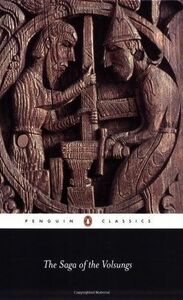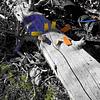Take a photo of a barcode or cover
"Beer I give you, Battlefield’s ruler,
With strength blended
And with much glory.
It is full of charmed verse
And runes of healing,
Of seemly spells
And of pleasing speech"
This is how I'm going to talk when it's my round in the pub and I'm bringing the drinks back to the table for my mates.
Wow! What an interesting way to use honey to kill a wolf!
With strength blended
And with much glory.
It is full of charmed verse
And runes of healing,
Of seemly spells
And of pleasing speech"
This is how I'm going to talk when it's my round in the pub and I'm bringing the drinks back to the table for my mates.
Wow! What an interesting way to use honey to kill a wolf!
I would not suggest this as an audiobook. The translator is the narrator. And while I'm often happy with read by the author audiobooks, a major exception for academics. The reading is incredibly bland.
Very fun, and a pleasant translation (with quite useful endnotes). A good way to spend time waiting in O'Hare.
Brynhild og Gudrun 4 president. Og hei Tolkien, jeg ser hvor du har funnet inspirasjon ;)
adventurous
inspiring
This was my first Norse mythology related read and it did not disappoint. It was magical from start to finish and I kept picking out little life and/or strategy lessons that have stood the test of time. For instance, it would appear that the Norsemen & women knew back then, in terms of strategy, what we lawyers only know too well now...
“You should only ask questions that you’ll be better knowing the answers to”
Another point of interest throughout the sagas were the female characters, a number of which were assertive, courageous, strong women who would often go and fight battles along with the men. Whilst I appreciate, the text is a “saga” and not necessarily reflective of general Viking life it was a breath of fresh air to read a medieval text/story where the female characters were not all expected to be hiding out in a castle or with the sole role of managing a family.
I’m looking forward to my next Norse Mythology book... I’ve been well and truly captured by the magical storytelling and the Viking adventures.
“You should only ask questions that you’ll be better knowing the answers to”
Another point of interest throughout the sagas were the female characters, a number of which were assertive, courageous, strong women who would often go and fight battles along with the men. Whilst I appreciate, the text is a “saga” and not necessarily reflective of general Viking life it was a breath of fresh air to read a medieval text/story where the female characters were not all expected to be hiding out in a castle or with the sole role of managing a family.
I’m looking forward to my next Norse Mythology book... I’ve been well and truly captured by the magical storytelling and the Viking adventures.
I'm really loving reading more into Northern European epics! I learned nothing about this in school, which I think is a bit weird. We only learned about the major gods, but only to explain the names of the days of the week, and that's practically all. Normally I'm not that much for nationalism, but maybe we would be a bit less harsh on other cultures if we understood our own culture a bit more.
This saga reads like a translation, but that does not detract from the storyline or the history and myth found within. This is one of the best known Icelandic stories and the translation with notes is helpful in getting the full meaning behind the text.
This is probably one of my favorite sagas and one of my favorite works of medieval literature in general - it's a fun epic that keeps readers wondering what fantastical thing will happen next, and it's not short on characters that stick with you as the story advances. While people more familiar with the workings of medieval heroic literature may derive the greatest benefit from reading this saga, it's also accessible to non-specialists and people who are just getting into older literature.
Things I Liked
1. Fantastical Elements: This saga is bananas. Wild things happen at every turn from shapeshifting to treachery to Odin walking around and dragon fights. Because of the sheer abundance of fantastical elements, there’s a little bit of something for everyone, and the saga absolutely takes each of these elements as legitimate storytelling devices. In other words, there is no sense that any of the magic or supernatural stuff is in here ironically - the saga-writer definitely considered each episode to be necessary in relating the history of the Volsungs.
2. Intertextuality: Although there’s no explicit reference to a source text or to other works of literature, I love that that this saga is so widely connected to other stories and artifacts from all over Europe. Because the Volsung legends were so popular, they show up in just about everything: Beowulf, The Nibelungenlied, and a lot of medieval art. Knowing this gives readers a sense of larger connectedness when reading the saga - you’re not just diving into Norse history and culture, but potentially a whole web of cultures.
3. Similarity with a Difference: For much of early medieval fantastical literature, there are certain formulas that structure the text, especially when relating stories about heroes or kings. For example, it’s a common trend to depict heroes as the product of incest or as fostered by wolves, and characters in the Volsunga saga definitely utilize Indo-European storytelling traditions. Rather than make this saga seem unoriginal, it actually made me think of the ways that the saga writer tried to make innovations. It was easier to see moments when the story broke from tradition or put a new spin on it, and I thought that was a really beneficial way of reading an early medieval text.
4. Women: It has become a stereotype that women in medieval literature are powerless, but that’s not the case in this saga. I really found the characters to be more in control of their actions and/or participants in their own stories, which I had noticed was lacking somewhat in a few sagas I read previously. Though the women may seem like stock characters in Volsunga saga, they’re well-developed and realized, and anyone who enjoys medieval literature yet tires of the lack of strong women might find delight in this book.
Things I Didn’t Like.
Nothing. I loved it all!
Recommendations: Enthusiasts of Norse or medieval history and culture will definitely love this saga, as well as anyone with an interest in heroic fantasy literature. You may also like this book if you enjoyed Beowulf, The Nibelungenlied, The Prose Edda, or History's tv show Vikings.
Things I Liked
1. Fantastical Elements: This saga is bananas. Wild things happen at every turn from shapeshifting to treachery to Odin walking around and dragon fights. Because of the sheer abundance of fantastical elements, there’s a little bit of something for everyone, and the saga absolutely takes each of these elements as legitimate storytelling devices. In other words, there is no sense that any of the magic or supernatural stuff is in here ironically - the saga-writer definitely considered each episode to be necessary in relating the history of the Volsungs.
2. Intertextuality: Although there’s no explicit reference to a source text or to other works of literature, I love that that this saga is so widely connected to other stories and artifacts from all over Europe. Because the Volsung legends were so popular, they show up in just about everything: Beowulf, The Nibelungenlied, and a lot of medieval art. Knowing this gives readers a sense of larger connectedness when reading the saga - you’re not just diving into Norse history and culture, but potentially a whole web of cultures.
3. Similarity with a Difference: For much of early medieval fantastical literature, there are certain formulas that structure the text, especially when relating stories about heroes or kings. For example, it’s a common trend to depict heroes as the product of incest or as fostered by wolves, and characters in the Volsunga saga definitely utilize Indo-European storytelling traditions. Rather than make this saga seem unoriginal, it actually made me think of the ways that the saga writer tried to make innovations. It was easier to see moments when the story broke from tradition or put a new spin on it, and I thought that was a really beneficial way of reading an early medieval text.
4. Women: It has become a stereotype that women in medieval literature are powerless, but that’s not the case in this saga. I really found the characters to be more in control of their actions and/or participants in their own stories, which I had noticed was lacking somewhat in a few sagas I read previously. Though the women may seem like stock characters in Volsunga saga, they’re well-developed and realized, and anyone who enjoys medieval literature yet tires of the lack of strong women might find delight in this book.
Things I Didn’t Like.
Nothing. I loved it all!
Recommendations: Enthusiasts of Norse or medieval history and culture will definitely love this saga, as well as anyone with an interest in heroic fantasy literature. You may also like this book if you enjoyed Beowulf, The Nibelungenlied, The Prose Edda, or History's tv show Vikings.






